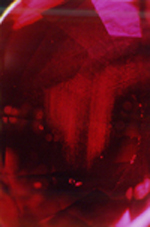UNTREATED AND
HEATED RUBY
When comparing Mogok rubies
on the quality scales for untreated
and heat-treated rubies, there
is a noticeable difference
in transparency, resulting
in a difference in color and
beauty. Untreated material
is a refreshing transparent
red, while the treated material
has somewhat lower transparency
and diminished clearness. This
is due to changes in the material's
internal characteristics and
surface, the effect of high
temperatures on the ruby crystal.
It is difficult to look at
an individual stone and determine
if it is heat-treated or not,
but when making comparisons
over the whole quality scale,
differences can be noted. It
is understandable how some
ruby dealers in the cutting
locales can claim to be able
to make this distinction when
comparing several rubies together.
It is also usually possible
to separate untreated and heat-treated
rubies by observing inclusions
through a microscope. Untreated
Mogok rubies often contain "silk" inclusions
that intersect at 60 degrees,
as shown in the photograph.
On the other hand, the surfaces
of heat-treated material may
have traces of holes caused
by the heating process. Chemicals
used during the heating process
may also remain as a glass-like
material within surface cracks.
The best way to determine whether
a stone is untreated or heat-treated
is to find out its pedigree.
It is becoming increasingly
important to understand where
a stone was mined, who supplied
it, and how it was processed
and polished. Supporting scientific
analysis and accumulation of
data can assist in clarifying
the origins of a stone. |
|
|
Untreated Mogok Ruby
Beside silk inclusions that intersect
at 60 degree angles, stubby crystal
inclusions may also be seen in
Mogok rubies. |
 |
Silk and Crystal Inclusions
Mogok Ruby
Untreated
Magnification : 28x |
Heat-Treated Mogok
Ruby
Heated corundum may also contain "snowball" inclusions,
as shown in this photograph. These
are included crystals that have been
melted by the heating process, becoming
rounded like a ball. |
 |
Snowball
Inclusions
Mogok Ruby
Heated
Magnification : 63x |
|
 |
JUDGING QUALITY
Exceptionally beautiful rubies with
beauty grades of S or A in the
most popular tone levels of 5 to
6 are considered gem quality. In
small stones, tone level 4 in beauty
grade S or A is also an attractive
quality level. However, there is
a large difference in value between
a tone level 4 that is closer to
5 and one that is closer to 3.
It has long been said that "pigeon-blood" is
the finest possible color for a
Mogok ruby. When asked exactly
what color this refers to, local
dealers would always point out
a color with a tone level of 6
or 7. For a gemstone with a fairly
dark color to exhibit its full
beauty, it must have sufficient
size to allow a fine balance of
light areas to appear in the mosaic
pattern. "Pigeon-blood" does
not apply to 0.5-carat sizes, but
refers to a high quality found
only in large stones exceeding
2-carat size.
Eye-visible inclusions
are acceptable in Mogok ruby, as
a proof of natural origin, so long
as they do not adversely affect
the beauty of the stone. Silk inclusions
and "fingerprint" inclusions
(a type of liquid inclusion) will
give each gemstone its own individual
character. |
|